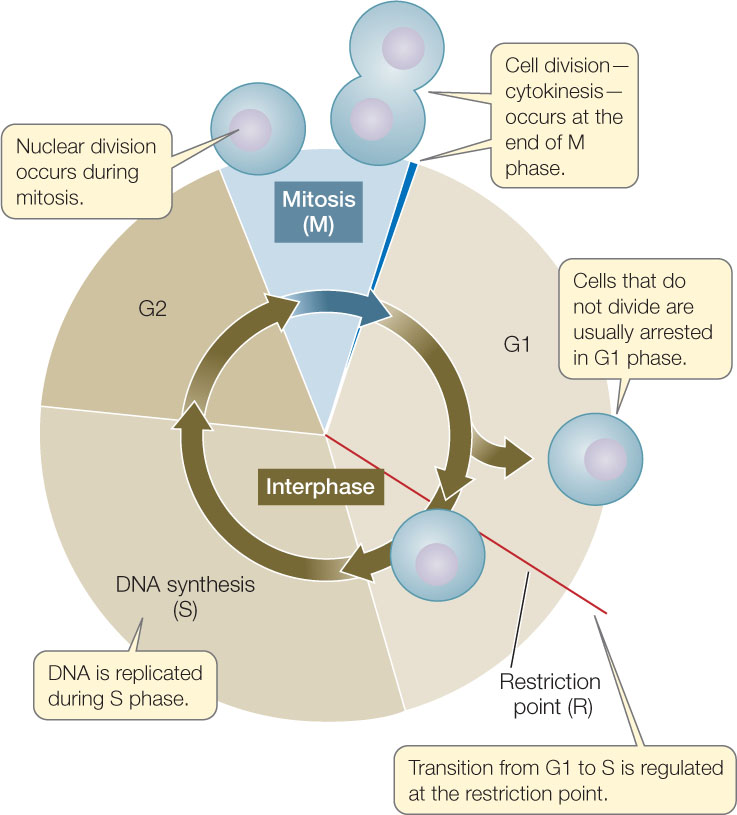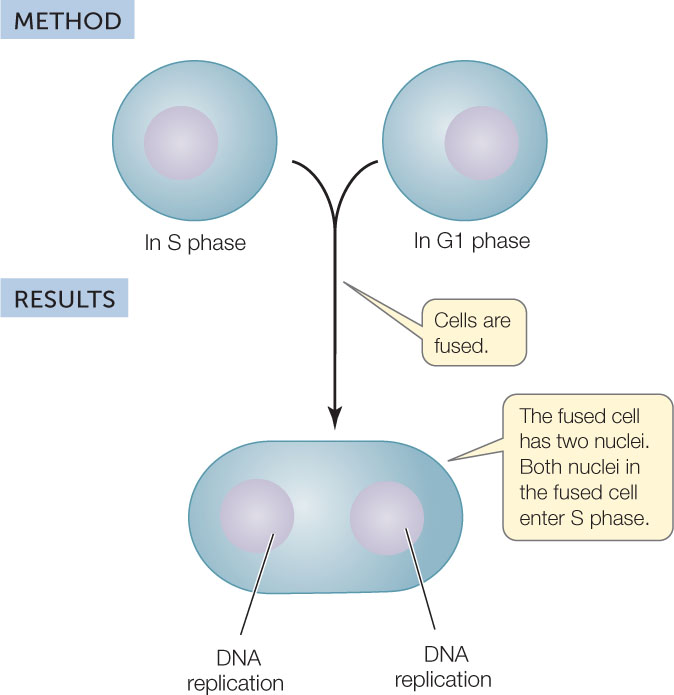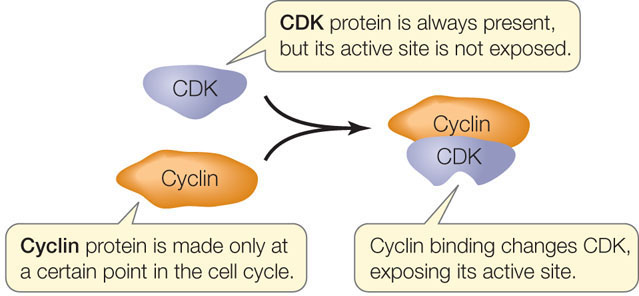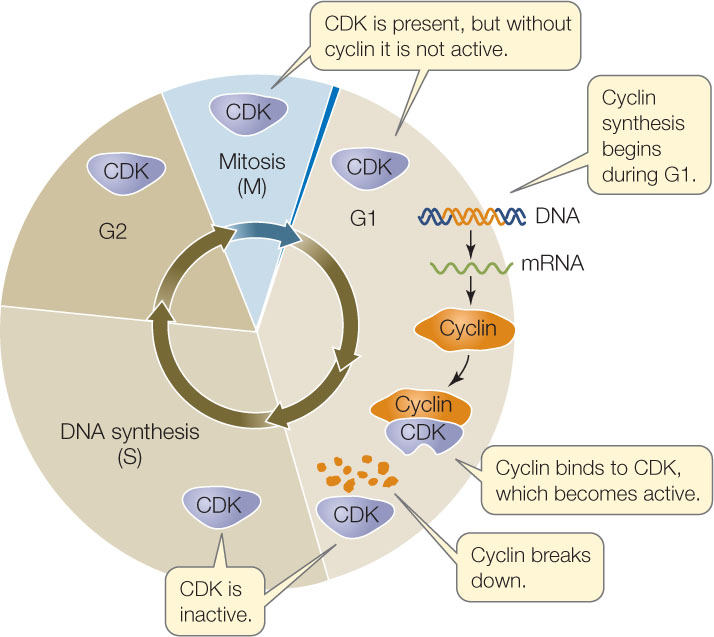Concept 7.3: Cell Reproduction Is Under Precise Control
Cell reproduction cannot go on continuously and indefinitely. If a single-celled species had no control over its reproduction, it would soon overrun its environment and starve to death. In a multicellular organism, cell reproduction must be controlled to maintain the forms and functions of different parts of the body.
Unlike prokaryotes, eukaryotic cells do not constantly divide whenever environmental conditions are adequate. In fact, the specialized cells of a multicellular eukaryotic organism may seldom or never divide. The signals for eukaryotic cell division are related to the needs of the entire organism. Mammals produce a variety of substances called growth factors that stimulate cell division and differentiation. For example, if you cut yourself and bleed, a blood clot eventually forms. Cell fragments called platelets in the blood vessels surrounding the clot secrete various growth factors that stimulate nearby cells to divide and heal the wound.
The eukaryotic cell division cycle is regulated internally
As we discussed in Concept 7.2, the eukaryotic cell cycle can be divided into four stages: G1, S, G2, and M. Progression through these phases is tightly regulated. For example, the G1–S transition marks a key decision point for the cell: passing this point (called R, the restriction point) usually means the cell will proceed with the rest of the cell cycle and divide (FIGURE 7.8).

What events cause a cell to enter S phase or M phase? A first indication that there were substances controlling these transitions came from cell fusion experiments. For example, an experiment involving the fusion of mammalian cells at G1 phase and S phase showed that a cell in S phase produces a substance that activates DNA replication (FIGURE 7.9). Similar experiments pointed to a molecular activator for entry into M phase.
Investigation
HYPOTHESIS
A cell in S phase contains an activator of DNA replication.

CONCLUSION
The S phase cell contains a substance that diffuses to the G1 nucleus and activates DNA replication.
ANALYZE THE DATA
The researchers used mammalian cells undergoing the cell cycle synchronously. Radioactive labeling and microscopy were used to determine which nuclei were synthesizing DNA; only nuclei that were synthesizing DNA became labeled:

- What were the percentages of cells in S phase in each of the three experiments?
- What does this mean in terms of control of the cell cycle?
Go to LaunchPad for discussion and relevant links for all INVESTIGATION figures.
aP. N. Rao and R. T. Johnson. 1970. Nature 225: 159–164.
The cell cycle is controlled by cyclin-dependent kinases
The molecular activators revealed by the cell fusion experiments turned out to be protein kinases, a class of enzymes that are common in cell signaling (see Concept 5.5). The kinases involved in cell cycle regulation are called cyclin-dependent kinases (CDKs). They catalyze the phosphorylation of target proteins that regulate the cell cycle:

As their name implies, CDKs are activated by binding to the protein cyclin. This binding changes the shape of a CDK such that its active site is exposed, and is an example of allosteric regulation (see Concept 3.4):
139

Several different CDKs function at specific stages of the cell cycle, called cell cycle checkpoints. At these points, signaling pathways regulate the progress of the cell cycle. For example, if DNA is substantially damaged by radiation or toxic chemicals, the cell may be prevented from successfully completing the cell cycle. So the damage to DNA is repaired before the cycle proceeds. There are three checkpoints during interphase and one during mitosis:
- G1 checkpoint is triggered by DNA damage.
- S checkpoint is triggered by incomplete replication or DNA damage.
- G2 checkpoint is triggered by DNA damage.
- M checkpoint is triggered by a chromosome that fails to attach to the spindle.
Each CDK has its own cyclin to activate it, and the cyclin is made only at the right time. After the CDK acts, the cyclin is broken down by a protease (FIGURE 7.10). So a key event controlling the transition from one cell cycle phase to the next is the synthesis and subsequent breakdown of a cyclin. Cyclins are synthesized in response to various molecular signals, including growth factors. This starts a chain reaction:
Growth factor → cyclin synthesis → CDK activation → cell cycle events

140
To illustrate the concept of cell cycle control by a particular cyclin–CDK complex, let’s take a look at the complex that controls the R point at the G1–S transition (see Figure 7.8).
The G1–S cyclin–CDK catalyzes the phosphorylation of a protein called retinoblastoma protein (RB). In many cells, RB or a protein like it acts as an inhibitor of the cell cycle at the R point. To begin S phase, a cell must overcome the RB block. Here is where the G1–S cyclin–CDK comes in: it catalyzes the addition of a phosphate to RB. This causes a change in the three-dimensional structure of RB, thereby inactivating it. With RB out of the way, the cell cycle can proceed. To summarize:

Now we can be more specific about the chain of events involved in growth factor stimulation of cell division: the specific cyclin whose synthesis is activated is the one that allosterically activates the CDK that phosphorylates RB, and this allows the cell cycle to exit G1 and begin DNA replication in S phase. This example illustrates how regulation of the cell cycle involves a number of cellular processes that we have examined in this and other chapters: signal transduction (see Chapter 5), gene expression and protein synthesis (see Chapter 3), and cell division.
CHECKpoint CONCEPT 7.3
- Draw a diagram and describe the events that occur in the four stages of the eukaryotic cell cycle (M phase, G1, S, and G2).
- Cultures of eukaryotic cells can be synchronized, so they are all at the same phase of the cell cycle at the same time. If you examined a culture at the beginning of G1, would the CDK that acts at the R point be present? Would it be active? Would its cyclin be present? What would your answers be if the culture were at the R point?
Binary fission and mitosis result in daughter cells with the same number of chromosomes as their parent cells. Sexual reproduction, however, requires a process of cell division in which the number of chromosomes is halved. We‘ll look at this process next.